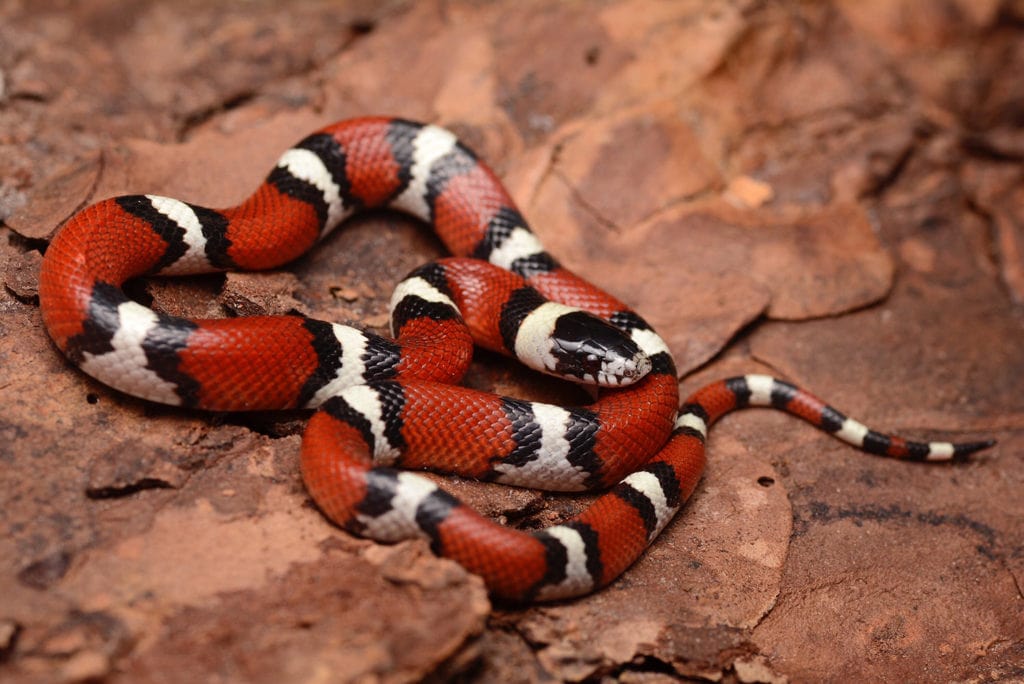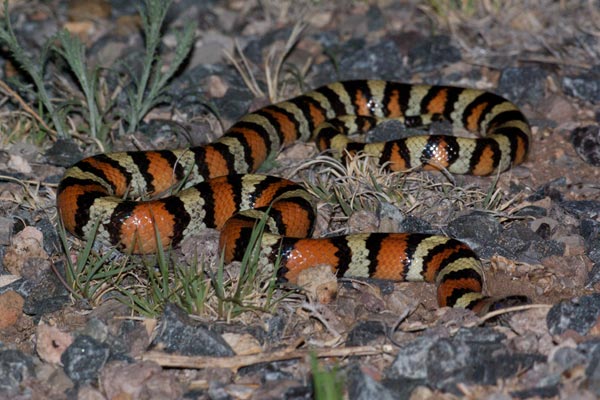

Honduran milk snakes adapt well to captivity due to their relative ease of care and docile nature, and their moderate size and brilliant colors make them impressive and attractive pets. The hatchlings are 8 inches long and darker in color than their parents when they emerge from the eggs. The eggs incubate for approximately two months, and hatch in August or September. The females are oviparous, laying an average of 3–18 eggs per clutch in early June. Honduran milk snakes become sexually mature at 18 months. In captivity they are kept successfully on a diet of mice and rats. The Honduran milk snake uses constriction to kill its prey and tends to be opportunistic when it comes to its diet they eat other snakes ( ophiophagy), including venomous snakes, lizards, rodents, birds and eggs. The Honduran milk snake inhabits low to medium elevations of the tropical areas of Honduras, Nicaragua, and Northeastern Costa Rica. The Honduran milk snake has a resemblance to the coral snake and this similarity in color, known as Batesian mimicry, helps protect the snake from potential predators.

The Honduran milk snake is one of the larger subspecies of milk snake, attaining a length of 48 inches in the wild and some captive specimens reaching a length of 5 feet. In some cases the yellow is actually a deep orange color and the animal in question is referred to as a tangerine phase. The Honduran milk snake's base color is red with distinct rings or bands of black and yellow. Its subspecific name hondurensis is a Latinization of their primary country of origin: Honduras. The maximum total length recorded for this species is 132 cm, although normal lengths range from 60-90 cm. The Eastern Milksnake, Lampropeltis triangulum is tan, brown or grey and has large, black-outlined, red or brown dorsal blotches that fade as the snake ages. Its specific name ( triangulum) is Latin for "triangle" and refers to the three colors found on the scales of the species (red, black, and yellow). Wildlife Species Description and Significance. The generic name ( Lampropeltis) is derived from the Ancient Greek lamprós (λαμπρος) meaning "bright" and peltas (πελτας) meaning "shield", after the sheen of their scales. Learn more about reptile and amphibian conservation and what you can do to help these species on our Reptile and Amphibian Stewardship page.A two-month-old albino Honduran milk snake Taxonomy Additional detail about legal protection for species at risk in Ontario is available on our Legal Protection page. The species’ status was last confirmed in 2010. The International Union for Conservation of Nature has not assessed the global status of the milksnake. The habitat of this species is further protected in Ontario by the Provincial Policy Statement under the Planning Act. These acts offer protection to individuals and their habitat. The species has also been designated as a Specially Protected Reptile under the Ontario Fish and Wildlife Conservation Act. Milksnakes are listed as of Special Concern under the federal Species at Risk Act. The milksnake was listed as Special Concern under the Ontario Endangered Species Act, 2007. The eastern milksnake’s status was delisted from being a species at risk in Ontario in 2016. Juveniles of these and other species look very similar and can be very difficult to differentiate. This behaviour, combined with the snake’s blotchy patterning, causes many people to mistake it for a rattlesnake. When threatened, the milksnake vibrates its tail and, especially when it comes into contact with dry vegetation, makes a buzzing or “rattling” sound. The eastern Massasauga is very thick bodied compared with the long, narrow milksnake and has a rattle on a blunt tail, a vertical pupil and a triangular head. The eastern hog-nosed snake has a distinct upturned nose. Eastern foxsnakes have a yellow to light brown body with brown blotches that are not outlined in black (although the blotches of juvenile foxsnakes can have dark edges). The northern watersnake’s patterning consists of horizontal banding rather than blotches and is very faint on a much darker body. The milksnake may be confused with the northern watersnake, eastern foxsnake, eastern hog-nosed snake and eastern Massasauga. A Primer on Wetland Offsetting in Ontario.Northern Ecosystems and Nature-based Climate Solutions.


 0 kommentar(er)
0 kommentar(er)
